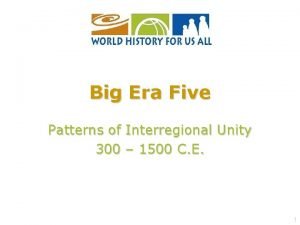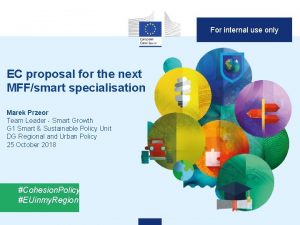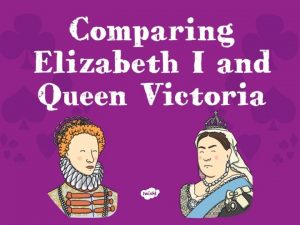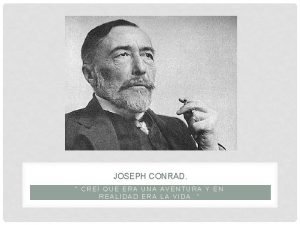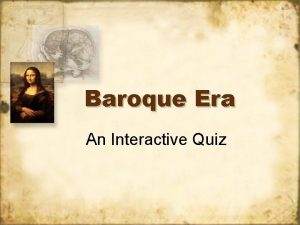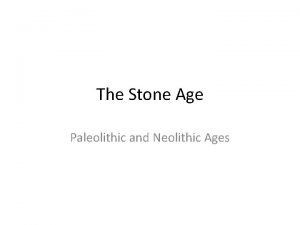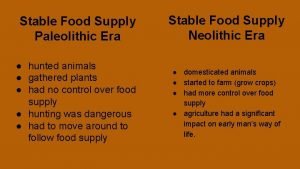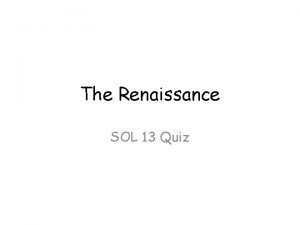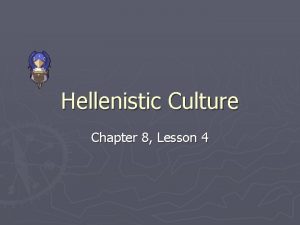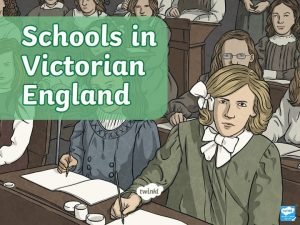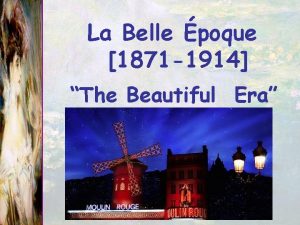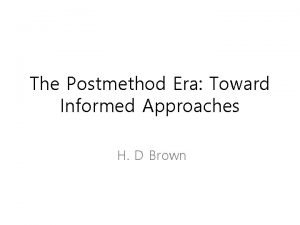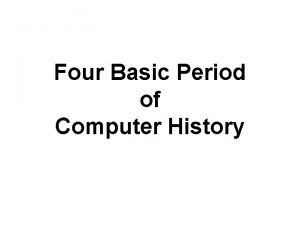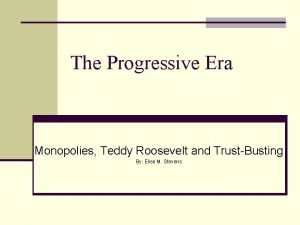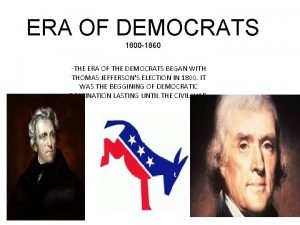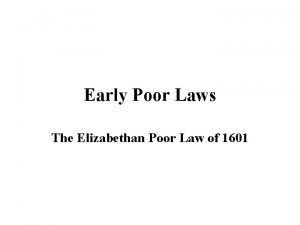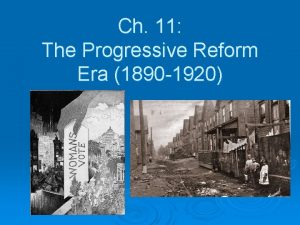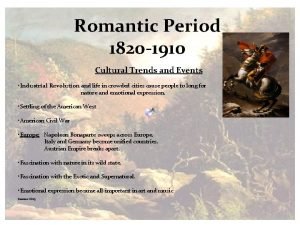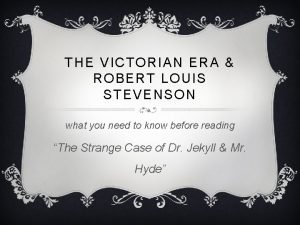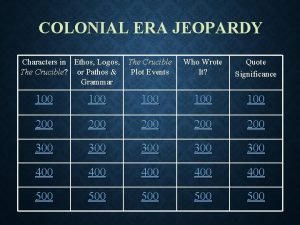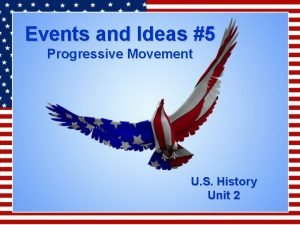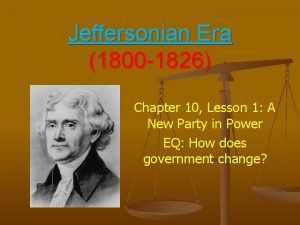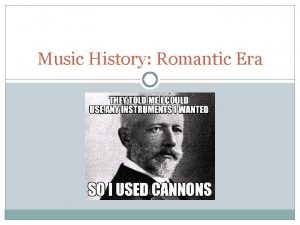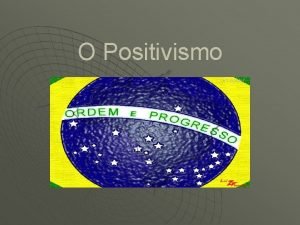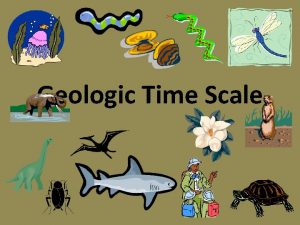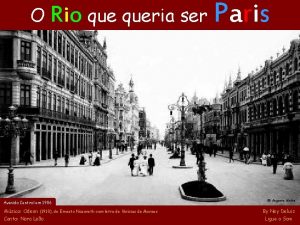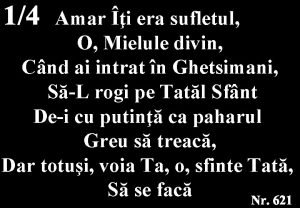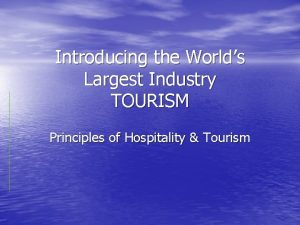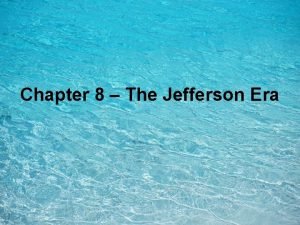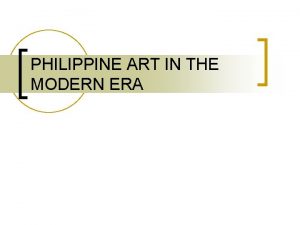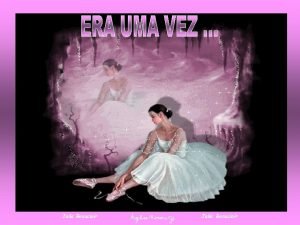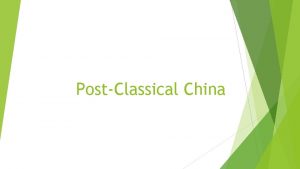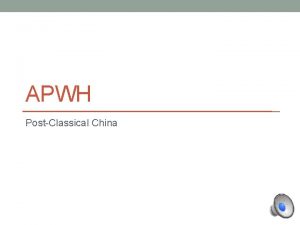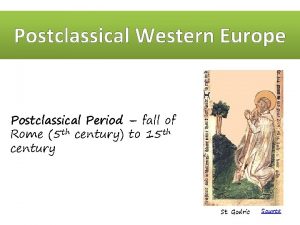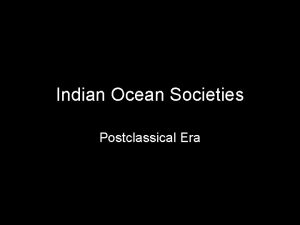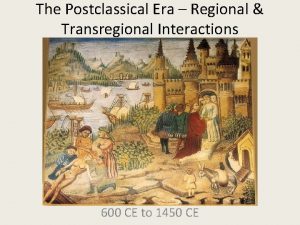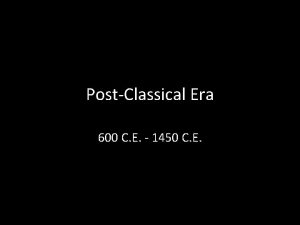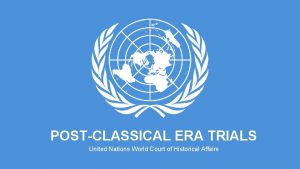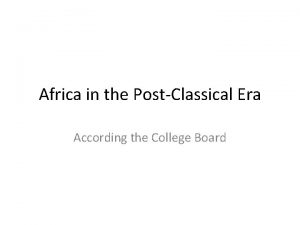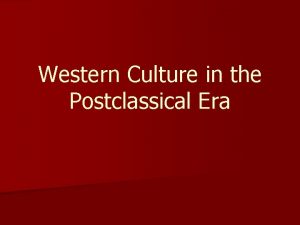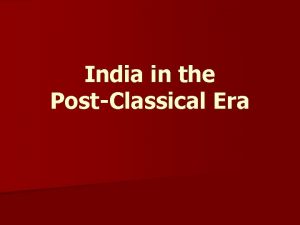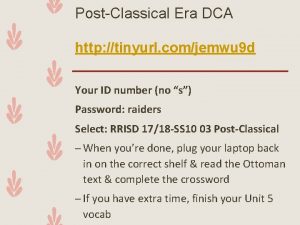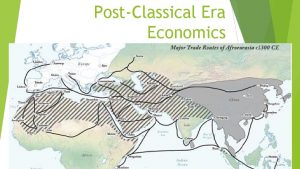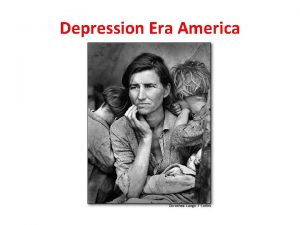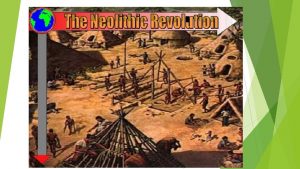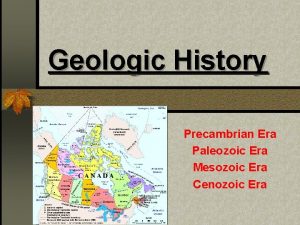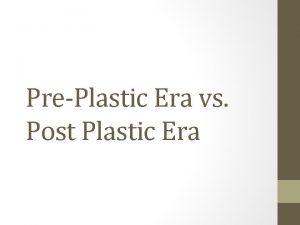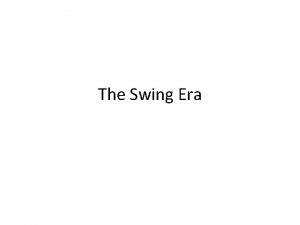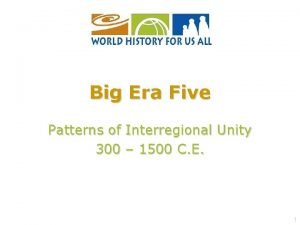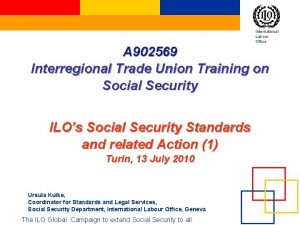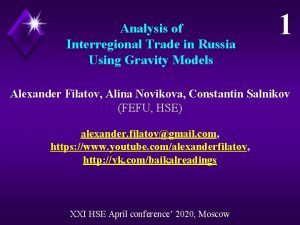Interregional Trade during the Postclassical Era EQ How











































































































- Slides: 107

Interregional Trade during the Postclassical Era EQ: How did interregional trade change during the time period 600 CE to 1450 CE? What continuities existed? Why did these changes and continuities occur? • Trade during the Middle Ages involved the expansion & intensification of existing trade routes and the development of new ones § Intensification of old routes => Silk Road, Indian Ocean network, Trans-Saharan routes and the Mediterranean sea lanes § New Routes => Hanseatic League & Mesoamerican networks • Q: Why Trade? => regional variations in resources and skills due to climate zones and technological development § i. e. varying distribution of gold in Africa, silk industry in China • Q: Why expansion and Intensification? . . . Many factors #1: States and Empires #2: Rise of Islam #3: Desire for luxury goods

Interregional Trade during the Postclassical Era #4: New forms of credit & money #5: State sponsored infastructure and trading organizations #6: Increase in technology • Trade networks of time period also led to cultural and technological diffusion, migrations, as well as the spread of disease (i. e. Black Plague) § New and expanded networks also led to the rise of new cities (i. e. Venice, Timbuktu) and the decline of others (i. e. Rome, Alexandria) • Also for the first time, individuals were able to travel from one end of the networks to the other => i. e. ______________

Eurasian Trade networks ca 1450 CE

European Trade and Hanseatic League European Trade during the Middle Ages was dominated by the Northern European Hanseatic League and the Southern European Venetian/Genoese trading cities

Trans Saharan Trade Routes (ca 1200 CE) Islamic Traders and the emergence of larger African states changed the style and function of Trans Saharan trade in the post-classical period

Indian Ocean Trade Network (ca 1000 CE)

Reasons for Intensification of Trade during Postclassical Era #1: Growth of ____________ • The growth of several multinational empires during the Postclassical Era greatly aided trade among civilizations § Empires included Tang China, Abbasid Caliphate (and others), Byzantine Empire and the Mongol Empire -- All empires drew many peoples into their trade networks and facilitated long distance communication through various methods o Tang China’s brief foray into Vietnam led to SE Asia becoming integrated into Indian Ocean & Silk Road networks o Mongols established courier system to link empire and used military force to reduce raiding along Silk Road -- _______and the security and stability provided by large empires greatly increased the volume of trade #2: Rise of ______ • Islam was a religion, more than any other centered on trade and commerce => Mohammad was a merchant before a prophet § Muslim merchants establish ___________in Malacca, East Africa, etc… that became very involved in Indian Ocean trade

Reasons for Intensification of Trade during Middle Ages § Islamic states stood at the center of networks => they were the hub of transregional trade in Sahara, Indian Ocean & Mediterranean -- Islamic culture & language became the standard for commerce => civilization spanned many cultures (ME, African, Indian, SE Asian) § Muslim merchants also many times formed joint ventures with Christian and Jewish merchants => 1 st ____________ #3: Desire for __________ • The rise of merchant communities, the urbanization associated w/ trade & the wealth of empires all led to a greater desire for luxury goods § Luxury goods were the #1 item traded in the Postclassical Era § _____ textiles => perceived as a status symbol in Europe and the ME; only the wealthy & the church could afford silk -- China had a monopoly on silk production during Classical Era, but by 1200 production had expanded to India, ME & Byzantines § _______ textiles => cotton was major export of India; also introduced in China; prized for its lightweight and breathable nature -- Production limited by India’s lack of commercial development => lack of status for merchants, state control of trade and lack of unifying empire

Reasons for Intensification of Trade during the Postclassical Era § ______ => invented by Ming Dynasty in 1400; highly prized in Europe, ME & South Asia due to its ability to not spoil taste of drinks § _______ => “spice islands” of Malay Peninsula and Indian pepper were also highly prized goods -- Salt traded from West Africa by Taureg nomads => salt traded in Timbuktu for gold in equal amounts (Q: Why valuable? ? ) -- Pepper traded from India => used to season food -- Cloves, nutmeg, mace, cinnamon traded from “Spice Islands” => flavored food and used as medicines § _____ => 80% of gold mined was mined in Africa (Mansa Musa) -- Gold trade helped to expand minting of coins (florins, etc…) § ______ => Eastern Europe & Africa were main slaving centers § Exotic ______ => Chinese and ME traders received rhinocerus horns (medicinal uses) and giraffes for zoos and displays

“Spice Islands” of Malaysia Spices such as cinnamon, nutmeg, cloves, etc. . From the Spice Islands were literally worth their weight in gold during the Middle Ages

African Salt & Gold Trade

Reasons for Intensification of Trade during Postclassical Era #4: New forms of ________=> due to the volume of trade and long distances, new methods of payment were devised § Venetians and other minted new coin $$ => gold florins § Some states also printed paper $$ => Tang China printed notes in 9 th century, but they inflated to 1% of value(not backed by gold) § Credit was also used for the first time, called “_______” in China => paper certificate that was used by govt (promised to be redeemed for coinage at capital) -- Used as currency by merchants (vs using large # of copper coins) § ___________ were also used by Italian bankers (i. e. Medici family) and at European fairs => promised holder that they could be redeemed at bank or another fair for amount of coinage -- These bills were often discounted (i. e. => gave $10 to get a $9 bill) => way around Christian ban on usury (interest) -- Italians and Jews dominated banking in Europe => Jews were not bound by usury laws and Italians invented ways around them

Venetian Banking House Florin dated 1253 Italian Banking houses were the forerunner of modern day banks and helped to create commercial capitalism of 16 th and 17 th centuries => they would have branches in ME Crusader states and other areas

Reasons for Intensification of Trade during Postclassical Era #5: State Practices and Trading Organizations • Many states and empires contributed to the encouragement of trade § ___________ => built by the Sui and Tang dynasties to link Northern and Southern chinese rivers § ___________ was also an organization created by Northern European cities to foster regional trade #6: Growth of Technology • Camel saddles and increasing levels of organization of caravans routes led to increased caravan trade across the ME and Africa § _________ grew up in ME along Great Persian road => roadside inns where travelers could sleep and gain supplies • Indian _______and ________also improved water travel => dhows incorporated lateen sails to better sail with wind § Boats also incorporated stern mounted rudders (better steering) § Size of dhows in Indian Ocean increased from 100 tons in 1200 to 400 ton by 1500 • Improved astrolabe (ME) and magnetic compass (China) also led to greater accuracy in sailing

Sui and Tang Grand Canal was used for regional trade (i. e. shipping rice to Northern China) as well as intl trade => silk and other goods shipped from Hangzhou

Caravanserais were usually located along travel routes and organized in a square => they had water and food for animals, a bazaar for merchants and sleeping quarters

Indian Ocean Dhows were very popular ships in the Indian Ocean trade networks due to their low cost, maneuverability. Often made of teak wood and sewn together (less likely to be damaged on reefs), they were sturdy and reliable

Astrolabe and Magnetic Compass A mariner’s astrolabe is used to measure the latitude of a ship using the sun’s position at noon or a star of known declination

Reasons for Intensification of Trade during Postclassical Era • ________also represent a technological development, based on environmental knowledge (i. e. like Indian dhows) § Longships were adapted to sail both on open water and in small rivers and estuaries (raiding and trading in Europe) § Leads Vikings to establish trade and settlements on coasts of northern Europe as well as inland Russia Q: What technological innovations do Viking longships have that can lend them to open water and river travel?

Viking Raids & settlements A combination of motives, capturing of slaves and booty mixed with a desire to secure permanent settlements, motivated Viking expeditions across the ocean and up various rivers in Eastern Europe

New Cities as commercial centers • Many cities during the Postclassical Era became hubs of trade and civilization => facilitated the exchange of goods, ideas and technology § European => Venice, Cordoba, Novgorod, Kiev, Flanders § African => Timbuktu, Kilwa § ME => Baghdad, Damascus, Aden § Mesoamerican => Tenochtitlan, Cahokia (N. American along the Mississippi river) § Asian => Hangzhou, Calicut, Melaka (Malacca)

Cordoba in 1000 CE The Mezquita at Cordoba “At the close of the 1 st millennium CE the greatest and most cultured city in Western Europe was not Rome, Paris or London. It was Cordoba, the capital of Arab Andalusia. . . There were parks, palaces, paved roads, oil lamps lighting the streets, seven hundred mosques, three hundred public baths and extensive drainage and sewer systems. Perhaps most impressive of all was the public library, completed around 970 CE and containing nearly 500, 000 books – more books than any European country contained. And it was merely the largest of seventy libraries in the city. . . No wonder that Hroswitha, a German chronicler called it “the jewel of the world. ” -- A History of the World in 6 Glasses (pg 93)

New Trading Routes • During the Middle Ages, commercial growth led to the creation of new trade routes also. . . #1: ________(1241) => N. European trade partnership (Baltic Sea) • Main cities = Novgorod, Ypres, Flanders, Antwerp, Hamburg • Hanseatic League = confederation of cities that had formed _____________(i. e. trading orgs that specialized in 1 commodity) § Each city wanted to foster trade with others and thus taxes were raised by taxing each guild and providing for a common army -- Armies protected trade routes after Mongol fall § Hanseatic League traded furs, wool, amber, timber to other European cities and Hanseatic League linked its routes to Mediterranean • Hanseatic League’s growth was aided by ____________ § Centered in Champagne area of France => series of 6 fairs were held annually in 6 large towns in France (i. e. Flanders, Bruges, Hamburg) -- Fairs were centers of exchange between Northern and Southern Europe => N goods (i. e. furs, wool, cloth, tin) were traded for Venetian goods (i. e. silks, sugar, spices, gold)

Hanseatic League

New Trading Routes #2: Mesoamerican Routes => after 500 CE trade routes began linking the Andes region, as well as Mesoamerica • Overland Trade => carried via Alpacas over Incan roads § Trade centered on luxury goods and metals (i. e. pottery, copper, gold/silver jewelry, textiles) § Linked Andean cities and civilizations like Moche, Wari, Inca • Pacific Ocean => trade carried on large balsa wood rafts between Mesoamerica and Andean S. America § Trade contacts led to spread of metallurgy to Mesoamerica (via S. America) and spread of Maize to S. America (via Mesoamerica) § Maritime exploration also led to the settlement of Carribbean islands by Arawaks (S. American tribe)

Mesoamerican Trade. Routes Balsa wood rafts that measured up to 36 feet in length were used to carry trade between S. America and Mesoamerica after 100 CE => each raft could carry up to 20 tons of cargo

New Trading Routes #3: Indian Ocean => all sea route from China to India/ME opened in 400 CE due to efforts of Malay sailors and SE Asian traders (piracy always problem) • With collapse of Mongol Empire in 14 th century, overland trade was severely disrupted => volume of trade in Indian Ocean increased • Indian Ocean route was also dependent on cooperation of _________________ rather than large commercial states (i. e. Silk Road) -- Diasporic cities => Muslim, Jewish, Chinese merchants • Major States § Swahili city states (___________) & Great Zimbabwe => traded gold, ivory, slaves and animal skins § _______ (ME city of Red Sea) => traded grain, opium, coffee & dyes § Indian Gujarat cities under Delhi Sultanate (i. e. ________) => traded cotton, indigo, cowrie shells, leather goods, gems & pepper § SE Asian empires like Sirijava & Majapahit vied for control of Strait of Malacca => by 1350 city of _______controlled trade -- Aided by ruler’s conversion to Islam -- Traded rubies & gems, spices (cloves, nutmeg), gold, tin • Trade in Indian Ocean controlled mainly by _______=> key to spread of Islam in region (i. e. Malacca, India, Swahili city states) § Piracy in Indian Ocean a constant problem => states try to control

The Temple at Borodobur Mountain shaped people of Malaysia initially worshipped mountains) structure w/ 10 levels => full of elaborate carvings and illustrations

Eurasian Trade networks ca 1450 CE

Results of Interregional Trade • Due to increased volume of trade & new trade routes, there were many important impacts of interregional trade during the Postclassical Era #1: Concentration of wealth => merchants during the time period became a new economic elites as trade enriched many areas • ______were well respected in ME and occupied a favored status => established many diasporic communities and spread Islam § Malacca in SE Asia, Mali in Africa, Andalusia in Spain, Samarkand in C. Asia (Silk Road), Egypt • Jewish merchants and the merchant communities in Italian city states (i. e. Genoa, Pisa, Venice) also concentrated wealth due to trade § _____________and letter of credit were precursors to the commercial capitalism that emerged in later centuries § Wealth concentration in Italy also led to the climate necessary for the Renaissance in the 15 th/16 th centuries • Kings in places like Malacca and Mali also showed vast levels of personal wealth based on trade (controlled key items) ** Hajj of Mansa Musa reading**

Results of Interregional Trade #2: Cultural Exchange • Religious exchange occurred most often on trade routes § Islam spread to _____(Mali Empire & Swahili city states), ____(Malacca), ______(Delhi Sultanate) & Central Asia (Silk Road trading cities like Samarkand) § Mahayana Buddhism was spread to _________like Srivijava (India) and Vietnam (China), as well as _____(Zen Buddhism) § Hinduism was spread by Indian traders to interior SE Asian kingdoms like ______=> developed castes system based on occupation • Crops and agricultural techniques § _______was spread from SE Asia to China (matures faster and increased yields) => leads to pop growth § ______________were spread from India to ME and throughout Mediterranean -- Led to textile industry in Europe and ME -- Europeans also desire to acquire land to cultivate sugar -- Citrus improves diet and reduces diseases like scurvy

Diffusion of Crops during postclassical era • Citrus, Cotton & sugar do not grow well above the 40 th parralel Q: What areas are open to their cultivation outside of India?

Eurasian Terrain

SE Asia in 1200 CE • The Kingdom of Angkor was based on the cultivation of champas rice => traded other items such as salt, honey and textiles • The empire declined by 1430 due to incessant wars with neighbors and silting of its irrigation canals

New Agricultural Techniques of Middle Ages

Results of Interregional Trade § Bananas were introduced by Malay traders and become important in Africa => high yields and ability to grow in jungled areas -- Preferred crop of Bantus (spread via migration) § Farming techniques like 3 field system, use of improved iron plows & horse collars were imported to Europe via Central Asian trade #3: Spread of __________=> diseases like Bubonic Plague, pnuemonic plague and measles/mumps spread during time period • Spread easily along trade routes and by large empires like Mongols due to ease of travel and contact

The Black Plague (14 th Century) • One of the most detrimental effects of Interregional trade during the Middle Ages was the outbreak and spread of infectious disease § During the Classical Era outbreaks of disease occurred => Measles and mumps outbreaks in Roman and Han empires; Black Plague outbreak in Mediterranean during the 6 th and 7 th centuries • Plague started in SE Asia or Central Asia and was spread by _____ along ______________=> linked most of Eurasian world § Plague particularly effected more urban settlements and areas => spread easily in dirty environments (i. e. Europe) -- Particularly hard hit were Egypt, Italy and China § Mortality is estimated to have been from_________ -- China: pop decline from 120 M (1340) to 80 M (1400) -- Europe: pop decline from 75 M (1348) to 37 M (1351) -- Egypt: pop did not reach pre-plague levels until 1800’s

Spread of Black Death (14 th century) Q: What was the pattern of spread of the Black Death? Why did this pattern emerge?

Medieval depictions of the Black Death Plague doctors – wore mask to cover up the stench (herbs placed in beak). . . Used medical techniques like bloodletting, use of urine as a disinfectant

Impact of the Black Plague in 14 th century #1: Religious effect => plague weakened the Catholic church due to inability to “stop” plague • Many looked for a scapegoat and in Europe that was the Jews => worst pogroms (massacres) were in Germany § Led to Jewish migration to Russia & Poland => offered protection • Other looked to “earn” god’s forgiveness by whipping themselves => ____________(popular in 1350’s until they targeted Jews) #2: Political Effect • Due to deaths ___________=> within 80 years their empire collapsed in China, Russia and Persia • Plague also weakened _______due to manpower shortages => led to growth in wages and more serf autonomy • Cities also declined in population as well as importance for over a century as food shortages followed #3: Economic Effect • Volume of _________dramatically § Fall of Mongol empire contributed, as well as deaths of many merchants and decline of cities and wealth (less desire for luxury goods)

A Procession of Flagellants A procession of Flagellants => during the Plague outbreak, flagellants would march through the countryside recruiting and offering penance to God through beatings

Migrations & their impact during the Postclassical Era • Throughout World history groups have migrated for various reasons => climate change, trade, conquest, living conditions § During the Middle Ages two significant migrations occurred that had significant effects on settlements, peoples and the environment. . . #1: _________Migration • Bantu language family originated in the Nigerian area => linguistic evidence shows that 300+ African languages are related to Bantu § Around 1 st century BCE Bantu people started migrating south and west § As they spread they brought _________ and agricultural crops (i. e. yams, millet) to other areas of Africa -- Led to rise of Great Zimbabwe & population growth § Migration also led to a degree of African cultural unity => similar traditions (i. e. music, kinship, social categories) • Bantu languages intemixed with other languages in areas of Africa to create unique new languages => i. e. Swahili § _________is a mixture of Bantu, Arabic & colonial languages § Swahili became a language popular in eastern Africa => Spoken by 140 M

Bantu Migrations (ca 300 BCE to 1000 CE) As the Bantu people migrated they brought knowledge of ironworking and agriculture (i. e. yams & sorghum) § Intermixing on the East coast of Africa between Bantu and Arabic language led to the development of Swahili

Migrations & their impact during the Postclassical Era #2: ____________Migration • Polynesian peoples originated in East Asia (i. e. Taiwan) around 8000 BCE and had sailed to New Guinea by 3000 BCE § Introduction of yam agriculture and animal domestication led to a population explosion => settlement of nearby islands § Established their own Polynesian culture based on farming, fishing on islands of the Pacific (i. e. Tonga, Fiji, Samoa) by 1000 BCE • Between 1000 BCE and 1000 CE Polynesians mastery of open ocean travel over long distances (using stars and currents) led to the colonization of far away Pacific islands (i. e. Hawaii, Easter Island) § Utilized fleets of large double hulled canoes => made carrying of animals (pigs, dogs) and plants (bananas, yams) to islands possible § Polynesians also made contact with the coast of South America => introduced chicken to S America and sweet potato to islands • Some settlements had disasterous ecological consequences § Easter Island settlements depleted natural resources (i. e. timber) due to population growth & religious practices (Maori heads) § Led to ______________=> decline of civilization

Polynesian Migrations Polynesian people navigated the Pacific Ocean using no advanced scientific instruments – instead they used techniques passed down by oral tradition that included identifying star patterns, cloud shapes and patterns and the colors of the ocean and sky at various locations. Easter island Hawaii are over 2300 miles from Samoa and Tonga.

Polynesian longboats could carry up to 100 people and various items for settlement or trade (i. e. chickens, grains, etc…)

Maori heads on Easter Island Large statues were part of the Maori religion (means to contact ancestors) but their creation consumed a large amount of resources (i. e. trees) which contributed to the ecological collapse of the island by 1700 due to deforestation and rat predation

Diffusion of Cultural, Literary & Artistic Traditions • Increasing contact and trade between regions and civilizations led to increasing amounts of cultural diffusion (Q: What is cultural diffusion? ) China & East Asia • The Tang and Song periods are seen as the height of Chinese artistic expression => great deal to do with influence of__________ § Buddhism & Daoism influenced the development of Chinese artistic styles in poetry/painting => focus on tranquility of nature -- Buddhist & Daoist painters believed that depicting nature could lead to realization of Dao/enlightenment -- Buddhist & Daoist painters also focused on portraying “idea” of mountain and depicted humans as small § Buddhism & Daoism also influenced Chinese poetry which often had nature, isolation and the shortness of life as themes • These ideas and themes were ________through trade contacts § Buddhism spread to Japan from 6 th to 8 th centuries & melded w/ Shinto beliefs => focus on nature & meditation (Zen Buddhism)

Tang China landscape painting (Daoist influenced)

Diffusion of Cultural, Literary & Artistic Traditions -- Japan § Buddhism and Chinese Confucianism influenced Japanese poetry, painting & architecture => focus on natural themes and mood -- Poetry => simplicity and often focused on nature (Buddhism) but also very structured (_______form; linked verses of 17 syllables) -- Painting => landscapes (i. e. rolling hills w/ rice field) -- Architecture => buildings designed to imitate Tang court; Japanese wood structures outlast Chinese • ____________ also played a key role in Japanese society § Neo Confucianism was brought to Japan via trade contacts in the Kamakura period (i. e. 14 th century) and was used for monk education § Tokugawa shogunate (16 th century) adopted it as the official state religion as a means of control => Focus on___________ -- Created a more rigid social hierarchy => samurai, farmers, artisans and merchants -- Also introduced more ethnocentrism into Japan => Japanese came to believe their rational culture was center of world

Diffusion of Cultural, Literary & Artistic Traditions -- Korea • Neo-Confucianism and Buddhism also played important roles in ______ § Korea was controlled by the Han dynasty for centuries and thus Koreans were exposed to Chinese civilization § Used Chinese institutions and ideology to create a Korean state by time of Tang dynasty -- _________ became state religion; Chinese art forms and architecture dominated capital city (Kyongju) -- Koryo dynasty (935 -1392) adopted a version of _______examination => limit power of Korean nobles -- Art focused on _________adopted from China and landscape painting § Koryo dynasty maintained a tributary relationship w/ China

Koryo Dynasty The Korean Koryo Dynasty was established by General Wang Kon in 935 => deeply influenced by the Chinese model

Diffusion of Cultural, Literary & Artistic Traditions -- Vietnam • Vietnam was ruled as part of China during the Qin, Han & Tang empires § After 1000 years of foreign rule, though, Great Viet gained their independence in 939 CE from the Tang Dynasty § Chinese rule left behind a powerful cultural and political legacy 1. Viet rulers used same political traditions to rule => styled as emperors, used civil service exams, 6 ministries and local/provincial governments 2. Vietnamese adopted _____________beliefs § Elite adopted Confucian practices while commoners practiced Buddhism & Daoism in concert w/ animistic practices § Confucian concepts like filial piety and role of family were also adopted => women maintained more rights than Chinese though -- Vietnamese women allowed to own property & initiate divorce => these were codified into Vietnamese legal code in 1460 3. Vietnamese also adopted Chinese artistic & literary styles => dynastic histories, poetry, porcelain and architecture 4. Chinese characters also from the basis for Vietnamese chu nom characters (Vietnamese written language)

Dai Viet during the Tang Dynasty After hundreds of year of foreign rule, Great Viet arose as an independent state => Vietnamese people have been fighting for 1000’s of years to be independent

One Pillar Pagoda in Hanoi The One Pillar Pagoda in Hanoi is done in the classic Chinese architectural style => it is a Buddhist temple and shaped like a lotus flower

Other Examples of Cultural Diffusion • In addition to Chinese influence in East Asia, there are many others examples of cultural diffusion and influence during the Postclassical Era 1. Indian Hinduism and Buddhism in SE Asia => Thai, Pagan & Angkor kingdoms adopt Buddhist religion (Theravada) & caste based societies § Kingdom of Angkor had a state Hindu cult w/ 1000’s of local deities, 100’s of temples and over 300, 000 priests § SE Asians also adopted Indian writing script and used it to create their own epics (i. e. Ramayana) § Buddhist architecture also dominated (i. e. stupa) in temples like Borobudur in Java & Shwedagon pagoda in Yangon (Myanmar) 2. Islam’s influence in Sub Saharan Africa & Malacca 3. Toltec/Mexica & Inca traditions in Meso. America

Borobodur in Java Borodobur is one of the greatest Buddhist shrines. It was organized into three levels of the stupa which represent the sphere of desire, the sphere of rom and the sphere of formlessness. It borrows significantly from Indian stupas in its shape, as well as the spire on the top.

Temple of Angkor Wat The temple of Angkor Wat uses Indian architectural techniques (domes, mound shaped) w/ Buddhist influences (delicate, ephemeral)

Kingdom of Angkor (or Khmer Empire) Angkor existed as a regional power from 802 -1432 => SE had little connection to trade routes and did not specialize in any export commodity

World Population through History 7, 000, 000 6, 000, 000 5, 000, 000 4, 000, 000 3, 000, 000 2, 000, 000 10 0, 00 30 0 B , 0 CE 00 80 BCE 00 30 BCE 00 10 BCE 00 BC E 0 10 CE 00 12 CE 00 14 CE 00 16 CE 00 17 CE 00 18 CE 00 19 CE 50 20 CE 0

Year Est. World Population Growth Rate 100, 000 BCE 30, 000 BCE 8000 BCE 3000 BCE 1000 BCE 0 CE 1000 CE 1200 CE 1400 CE 1600 CE 1700 CE 1800 CE 1950 CE 2000 CE 10, 000 500, 000 6 Million 50 Million 120 Million 250 Million 400 Million 375 Million 578 Million 680 Million 954 Million 1. 6 Billion 2. 5 Billion 6 Billion 0. 56% 1. 25% 4. 33% 4. 47% 7. 62% 0% 26. 49% -3. 18% 24. 15% 17. 65% 40. 29% 71. 28% 139. 74% 462. 42%

Agricultural Production in the Postclassical Era • Agricultural Production increased dramatically during the Middle Ages due to many new inventions and technological innovations #1: The ________=> adopted from central Asian nomads, the horse collar was used extensively in Europe and led to incr in yields § Horses plow faster and more efficiently than oxen #2: _________field system => used in Mesoamerica by the Aztecs, this system increased yields & allowed year round farming #3: _______ field system => used in Andes by the Incas, system greatly increased yields and allowed farming in colder climates #4: _________=> used in China, Andes and SE Asia, terracing allows more land to be cultivated in mountainous regions #5: _________ rice => adopted from SE Asia, the Chinese used this fast maturing rice to double their rice yields #6: _________ system => used in Europe, farmers rotated crops and left 1/3 of land fallow to return nutrients to field

New Agricultural Techniques of Middle Ages

Luxury Goods & Industry during the Postclassical Era • Due to increasing demand for luxury goods in Europe and the Middle East, some crops were transported and cultivated in equivalent climates § ________=> originated in India (still #1 producer) but also transferred to Egypt, Spain & Iran and grown for European & ME markets § _______ => originated in SE Asia, but imported to Middle East, Spain and Southern China § ________=> originated in SE Asia but imported to India, Spain and ME where cultivation expanded onto irrigated plantations ** Cultivation of water intensive crops and irrigation systems necessary to support citrus, sugar & cotton contributed to desiccation in ME** § _______ => originated in China but worms smuggled into Byzantine Empire where it became a major industry

Manufacturing during the Middle Ages • Manufacturing endeavors intensified in many regions of the world during the Middle Ages as well. . . #1: India => most trade was controlled by state monopolies and artisans/merchants occupied low position in society § Still India was ____________during Middle Ages => production increased due to local government sponsorship #2: Middle East => textile production increased due to cultivation of elaborate state sponsored irrigation canals § Iran had a burgeoning cotton textile industry #3: China => China expanded production of many items due to technological innovations and advances (i. e. gunpowder, compass, movable type printing) § _______=> Chinese perfected techniques for creating steel and produced 35, 00 tons in 11 th century (same as 18 th century British #’s) -- Produced arms, armor and agricultural implements § _________=> cotton was grown to produce textiles § ___________=> manufactured in larger quantities under the Song & Ming dynasties in distinctive blue/white and yellow combinations -- Extremely popular in Europe (Netherlands)

Ming Porcelain Vases This Ming Vase sold at auction in 2010 for a record $53 million

Chinese Blast Furnaces The Chinese were the 1 st to make steel in reliable quantities using refined processes => the Song were producing 35, 000 tons/yr in the 11 th century

Cycles of Decline & Recovery during the Postclassical Era • During the Postclassical Era factors contributed to a series of urban & demographic declines & revivals (world population growth charts) Factors contributing to Urban & populational Decline => exs: Athens, Rome, Pataliputra, Chang’an, Alexandria #1: ________=> invasions in various areas of the world contributed to urban decline as people fled cities (target of invasions) • Europe => Vikings decimated Northern European cities (100’s of raids) and Mongols destroyed Russian cities like Kiev § Fall of Roman Empire led to decline of_____________ • China => ______________contributed to urban decline § Mongols razed many cities => ______& 92 other cities destroyed § Chinese populational census reported 120 M in 1200; 60 M in 1300 • India => conquests of ______were responsible for the destruction of many cities (Timur’s invasions killed up to 5% of world population) § Timur razed ___________& destroyed the Delhi sultanate • Middle East => the Mongol & Tamerlane invasions, combined with the Crusades dealt Middle East a triple blow § Mongols razed Baghdad and killed the Caliph in 1258 CE

Death Tolls of Top 10 Wars in World History 1. 2. 3. 4. 5. 6. 7. 8. 9. 10. 78, 000 – World War II (1939– 1945) 40, 000 – Mongol conquests (1206 -1324) 25, 000 – Qing conquest of Ming dynasty (1616– 1662) 22, 000 – Taiping Rebellion (China, 1850– 1864) 20, 000 – World War I (1914– 1918) 16, 000 – White Lotus Rebellion (China, 1794 -1804) 13, 000 - An Lushan Rebellion (China, 755– 763) 10, 000 – Era of Warring States (China, 475 BCE– 221 BCE) 8, 000 - Red Eyebrows Rebellion ( China, 9 -24) 7, 000 – Conquests of Tamerlane (1370– 1405)

Cycles of Decline & Recovery during the Postclassical Era #2: __________ => spread of infectious diseases like the Black Plague along trade routes from China to the ME and Europe also decimated populations • Urban areas hardest hit due to disease spreading more rapidly in crowded environments => many European cities abandoned • Black Plague estimated to have killed as many as 200 M people, including 3060% of European population #3: Decline of ______Although overall agricultural productivity expanded during the Postclassical Era some areas experienced problems § China => systems of extreme taxation including the Well field system and tax farming squeezed producers and reduced yields § SE Asia and India => large scale irrigation systems in area were created and sustained by large states (i. e. Delhi Sultanate) -- Timur invasions and warfare after 1250 CE caused decline in these systems and thus lack of food (therefore urban decline) § Middle East => climate changes after 1100 CE caused a severe decline in agricultural productivity (region never recovered) -- Lack of upkeep on irrigation systems led to crop failures -- Too much irrigation led to desiccation in many areas

Spread of Black Death (14 th century) Q: What was the pattern of spread of the Black Death? Why did this pattern emerge?

Cycles of Decline & Recovery during the Postclassical Era #4: The ___________ (see reading) • Starting in 1300 CE the earth went through a period of cooling for ~400 yrs • Why? => decline in sun spots, eruptions of large volcanoes (i. e. Mt Huanyaputina in Peru) and decline in human population • Effects => caused events like the Great European famine of 1315 -17 CE § Harvests decimated by early and late frosts, cool temps § Led to starvation, infanticide and cannabalism § Decline in trade due to frozen rivers § Led to increased rainfall in Sahara & retreat of desert (i. e. Timbuktu)

Worldwide temperature by Century

Cycles of Decline & Recovery during the Postclassical Era Factors Contributing to Urban and Populational Increase => key cities like Novgorod, Timbuktu, Venice, Huangzhou, Calicut, Baghdad, Malacca #1: End of Invasions • Rise of Feudal systems in Europe brunted Viking invasions and various interludes such as _____________led to an increase in urban population • After the fall of the Yuan empire in the 14 th century invasions declined due to introduction of __________(Chinese, Ottomans, Europeans) #2: Rise in Agricultural productivity => great rise in agricultural productivity was the #1 factor in increasing populations (Q: Methods? ) • 2 nd Great trip point in human populational increase => Q: 1 st? ? #3: Reliability of safe and reliable transport • Large empires of time period (i. e. Mongol, Abbasid, Tang, etc…) led to revitalization of __________________network and thus trading cities § Mongols fought to keep Silk Road free of bandits § Islamic empires thrived on trade and improved camel transport networks => _____________and camel saddles § Ocean travel facilitated by advances in dhow and junk ships (larger, stern rudders) and use of ___________(post 1200 CE)

Caravanserais were usually located along travel routes and organized in a square => they had water and food for animals, a bazaar for merchants and sleeping quarters

Cycles of Decline & Recovery during the Postclassical Era #4: Rise of ___________ • Islam greatly encouraged commerce and from 800 CE -1300 CE commercial networks greatly expanded => profit & other motives § Islamic trading cities (_________) linked ME to both China (______), Africa, India (______) & Europe (____) § Islamic culture also greatly encouraged urbanization => means of religious conversion and cultural activity -- i. e. madrasas & libraries in Cordoba; House of Wisdom in Baghdad • New innovations (i. e. __________) fostered development of trade cities, especially European centers such as Venice & Genoa § Venice developed large mercantile fleet and conducted trade w/ ME § ________encouraged N. European cities and trade growth § MA Trade fairs also encouraged European trade #5: Warm & stable temps from ___________ • Europe, ME, India and China experienced stable, warm temperatures from over 500 yrs during Middle Ages § Led to reliable harvests and populational growth (cities prospered)

Hanseatic League

Eurasian Trade networks ca 1450 CE

Cycles of Decline & Recovery during the Postclassical Era #6: Availability of __________ • Population growth after 1000 CE led to a surplus of labor => thus spurring growth of artisans and cities § Artisans in many regions est. trade guilds => orgs of craftspeople (i. e. candlemakers, butchers, weavers) who traded on a common street • Organization of many labor systems also helped to increase productivity of labor => i. e. mi’ta, coervee, guilds, tax farming, feudalism, slavery

Cities During the Postclassical Era • Cities in the postclassical era served many of the same purposes as before => trade, religious & cultural activity, interaction & govt. power § Venice => center of Mediterranean trade (established ports on the Black Sea and Middle East Crusader states) -- During the later Middle Ages many cities were also the site of the first _____________ -- First Universities were in Bologna and focused on liberal arts, law, theology and medicine -- Universities trained Middle Ages doctors, lawyers & govt officials § Baghdad, Timbuktu, Cordoba, Cairo => centers of ME universities (House of Wisdom), libraries and Islamic thought (also trade) -- Baghdad & Cairo also seat of Islamic caliphate (Abbasids) § Constantinople => center of east/West cultural exchange; silk industry, cotton textiles, citrus farms, Orthodox church ** Many of major cities of the Classical era had declined and were replaced by other cities => why decline and replacement? ? **

World’s Largest and most Central Cities Classical Era 1. Rome 2. Pataliputra 3. Carthage 4. Alexandria 5. Constantinople 6. Chang’an 7. Teotihuacan 8. Athens 9. Persepolis 10. Babylon 11. Damascus 12. 13. 14. 15. 16. 17. Middle Ages 1. Baghdad 2. Calicut 3. Timbuktu 4. Cairo 5. Constantinople 6. Chang’an 7. Tenochtitlan 8. Malacca 9. Cordoba 10. Sana 11. Huangzhou 12. Venice 13. Cusco 14. Samarkand 15. Delhi 16. Kiev 17. Kilwa

Islamic Trade Bazaars Trade bazaars were often the center of Islamic cities => contained goods from both East and West, as well as strictly controlled food

European Medieval Universities During the Middle Ages there were over 80 Universities in Europe => most pursued a liberal arts focus and focused on lecture -- No exams but to gain a degree you had to pass an oral exam by a committee

Cities During the Postclassical Era • However, cities also served new functions and were organized differently in different areas of the world. . . § Islamic cities (i. e. Baghdad, Cairo)=> organized around trade -- Largest buildings = palace of caliph, mosques and other public buildings (fountains, courtyards, public baths) -- Trade bazaar located at center of city § Chinese cities => Chang’an, Huangzhou -- Some were more trade oriented (Huangzhou), others were adm centers (Chang’an or Khanbaliq) for Confucian officials -- Became centers of industrial production also => steel, textiles, silk -- Chinese cities were also organized to provide many forms of entertainment => i. e. boxing, plays, musicians, festivals § European cities => Flanders, Venice -- Centers of trade and freedom -- Organized by trade guilds => each had a street -- Smaller in size than other M. A. cities => Venice in 1450 (100, 000) vs Baghdad at its height (700, 000) vs Chang’an (1 million)

European Cities as Centers of Freedom European Cities as centers of freedom and innovation • European cities of the Middle Ages were different than any other area § New European cities (and old Roman ones) were centers of trade and thus needed mobility more so than feudal serf farmers -- Paid kings and lords to have their own city “charters” => thus governed independently with different rules and restrictions § Examples of burgher “freedoms”. . . -- Right to inherit property -- Freedom from military obligations -- Right to choose own officials and church leaders -- Written laws that guaranteed independence from state § New city residents were called _____________ mostly artisans, merchants and industrialists § Cities of this sort very popular in Italy & Germany -- Some areas tried to forcibly gain independence via commune movement => most failed in areas with stronger monarchs • Medieval European towns took on their own character => walled cities for protection w/ narrow streets dominated by merchants and guilds § Crowded due to expensive cost of being inside walls => centers for disease, rodents and sewage (wells for drinking)

Middle Age European guilds Craftsmen of any sort (i. e. weavers, blacksmiths, candlemakers, etc…) formed guilds in European cities to collectively sell items and gain concessions from government => each guild had its own street in the city

Rise of European Kingdoms • During the late Postclassical Era (i. e. 1300 CE onwards) Europe became a pluralistic state with many competing monarchies and city states Italian & German City States • German & Italian princes and Pope control dozens of small principalities => leads to greater local freedom and autonomy but lack of unity England • After 1066 Norman invasion William I created a strong centralized monarchy in England (still a vassal to king of France though) § Over the years, though many events caused England to become more of a ______________ -- _________(1215) => limited power of king -- Parliament (1300) => Two knights from every county, 2 reps from every town and feudal lords meet to discuss taxation, laws etc… ** Discuss influence of Robin Hood mythology** French Kingdom • Originally broken up into three sections at the end of the Carolingian Empire (850 CE) => King Phillip II consolidated power in 13 th century

Europe in the High Middle Ages

Rise of European Kingdoms § French power became very centralized => officials appointed by King § Establishment of Estates General in 1300 => made up of reps of 3 groups in French society (nobles, clergy, commoners) Iberian Kingdoms • Christian knights established kingdoms of ______________ to remove Muslims from Europe (did by 1500) Holy Roman Empire • Otto I was crowned Holy Roman Emperor by Pope in 962 => empire was a loose confederation of German & Italian city states § Tried to control Church by selecting Bishops & Pope (lay investiture controversy) => lost power after ____________(1122) § Tried to control Italy by taking resources => lost many wars and thus weakened Empire Kievan Rus • Viking leader Oleg settled in modern day Ukraine and established 1 st Russian kingdom => Vikings became Rus ruling class (intermarried w/ Slavs) § Vladimir I married Byzantine princess & converted Russians to Orthodox Christianity

Labor Management Techniques in Postclassical Era • Overall, there were many continuities in the types and uses of labor systems between Middle Age and Classical societies. . . § Food production depended on a combination of free peasant agriculture and slavery or forced labor systems -- Great majority of workers also continued to be employed in food production of cereal grains (i. e. corn, rice, wheat, barley) § Social Hierarchies in most societies placed farmers at or near the bottom of social hierarchies (exception = Chinese) § Most societies also used a mixture of forced labor, labor obligation and free labor systems • However, there were also important changes in labor management during the Middle Ages. . . #1: Free Peasant Agriculture => important especially in Europe #2: Nomadic Pastoralism => migrate ~ 150 miles/yr (herds); militaristic #3: Guilds => craft & ind. production (master/journeyman/apprentice) #4: Coerced Labor => i. e. Serfs and mi’ta labor systems #5: Labor Taxes (govt) => i. e. Geld, (tax to pay for mercenaries) & coervee #6: Military Obligations => Incan & European Feudalism

Peasant Revolts in the Middle Ages There were literally hundreds of peasant revolts in different areas of the world during the Middle Ages => harsh working conditions, high taxation and church issues caused most of these revolts. Although popular, the pitchforks and crude weapons of the peasants were usually no match for trained armies and most failed.

Social Structures during the Postclassical Era • As in previous periods, social hierarchies were mainly shaped by class and caste hierarchies (continuity) Europe => social position was organized by class hierarchies => class and social position in feudalism was based on land occupation • Hereditary monarchies and status (i. e. France, England) present during the time also made social mobility difficult to achieve • The social position of ____________improved during the later Postclassical Era => Italian merchants respected & usury laws relaxed § Involvement in church building, financing of the Crusades & Renaissance increased their prestige & acceptance by Catholicism • ________also existed outside of class hierarchies and formed their own enclaves of special privilege => opportunity for social mobility **Aztec & Japanese societies also based on strict social hierarchies** China => social position continued to be determined by land, wealth and position, often determined by success on Civil Service Exams • Landed aristocracy continued to have most candidates w/ success on Civil Service examination => path to success and social mobility § Dominated by scholar gentry & males but more egalitarian than others => enforced a sort of cultural uniformity on China

Feudalism Hierarchy

Aztec Hierarchy

Social Structures during the Postclassical Era • Land consolidation also occurred during the Song => led to aristocratic dominance in rural areas and of government by wealthy families • ____________in China still not regarded with much respect => seen as a symbol of decadence and foreign influence • Japan & Vietnamese adopted the Chinese Civil Service examinations, but they did not impact social hierarchies (did reinforce idea of cultural pride) India • Despite the introduction of Islam to India during the Delhi Sultanate (10 th and 11 th centuries) India’s caste & class system was unchanged § Castes system did become _______=> Muslims incorporated into Indian castes (i. e. Indian rulers joined Brahmin or kshatriyas) -- Castes formed for different occupations => fishing, pottery, weaving § Restrictions of caste system may have been partially responsible for lack of commercial activity in India during Middle Ages -- Castes could not overlap duties and also could not trade outside geographic area => limited trade opportunities -- Govt monopolies existed on trade & merchants accorded a low status § Indian hierarchical caste system imported into areas of SE Asia => Angkor and Pagan organized society into varna castes based on occupation

Indian Caste System Indian Caste system provided social organization, economic justifications and political framework to India => formed a sort of identity far different from territorial sovereignty in Europe

Family & Gender during the Postclassical Era • Patriarchy persisted in almost all societies during the Postclassical Era as represented by the following developments and practices. . . § Hindu India => practice of _____(widow sacrifice) often as a means of the family of dead male acquiring property from sacrificed widow -- Widows who did not participate were expected to live ascetic life § Neo-Confucian China => practice of ___________ -- Practiced by all classes, a means of emphasizing female virtues of submissiveness and self discipline -- Limited opportunities and mobility of females § Islamic society => introduction of _________(separate female living quarters for an Islamic household) -- Started by Abbasids under Harun al Rashid => tradition of polygyny allowed for Muslim males (women maintain fidelity) -- Islamic practice of head & body covering also begun -- Islamic society strictly restricted activities of females => cloistered in home & not allowed public contact w/ males § Feudal Japan and Europe => women (especially aristocratic) were managers of household finances and supplies (domestic sphere) ** Harem culture spread to India where it evolved into the purdah => seclusion of wives and women from public life (also covering of head) **

Islamic Harems were basically the living quarters for all female members of a household => harem of Harun al Rashid included his wife, sisters, mother, concubines, etc….

Family during the Postclassical Era • Family relations also differed dramatically based on culture => majority of familial organization was a continuity from previous time periods § European society had developed a tradition of _______=> husband/wife and children § Chinese society was organized into __________=> at least three generations in one household Q: Why? ? ? -- Chinese tradition of clan organization an ancestor veneration => ancestors were important in familial shrines -- Prevalence of rice farming (labor intensive) & lack of arable land -- Due to influence of Neo Confucianism Chinese family culture became obsessed with filial piety (#1 goal of family life) v Arraigned marriages common, parents selected careers, familial shrines contain accounts of filial piety § Indian society organized in_____ units => 100’s of nuclear families that would be bound to a single occupation or caste group -- Served as a social safety net

Family during the Postclassical Era § African society organized into nuclear families tied to lineage groups (similar to clan or jati) => villages organized into lineage groups -- Islamic African kingdoms like Mali did not develop harem cultures and seclude women like Indian cultures did § SE Asian society was organized into nuclear family units => more available land higher status for women in many cultures -- SE Asian culture did import the idea of filial piety from China => respect for elders was valued and held as an ideal • Overall, some cultures and areas did develop significantly more social opportunity and power for women during this time § SE Asia § Mongol China § West Africa § Japan => Introduction of Buddhism initially limited women’s participation (i. e. monasticism only) by forbidding them from visiting shrines and denying them enlightenment, but eventually women became full participants







 Interregional unity definition
Interregional unity definition Interregional innovation investment instrument
Interregional innovation investment instrument Interregional innovation investments
Interregional innovation investments Immigration policies definition ap human geography
Immigration policies definition ap human geography Victorian era vs elizabethan era
Victorian era vs elizabethan era Creí que era una aventura y en realidad era la vida
Creí que era una aventura y en realidad era la vida Poema sobre as estrelas
Poema sobre as estrelas Era quiz: the baroque era
Era quiz: the baroque era Trade diversion and trade creation
Trade diversion and trade creation Fair trade not free trade
Fair trade not free trade Trade diversion and trade creation
Trade diversion and trade creation Trade diversion and trade creation
Trade diversion and trade creation Trade diversion and trade creation
Trade diversion and trade creation Ted talk atlantic slave trade
Ted talk atlantic slave trade Types of tramp chartering
Types of tramp chartering The trade in the trade-to-gdp ratio
The trade in the trade-to-gdp ratio Neolithic health
Neolithic health Paleolithic food supply
Paleolithic food supply Northern renaissance thinkers merged humanist ideas with-
Northern renaissance thinkers merged humanist ideas with- Physical activity was historically primitive.
Physical activity was historically primitive. During the free banking era between 1837 and 1863
During the free banking era between 1837 and 1863 Aleppo and jericho are located in
Aleppo and jericho are located in Who was the most famous scientist of the hellenistic era
Who was the most famous scientist of the hellenistic era Education during the victorian era
Education during the victorian era V. c c
V. c c Vẽ hình chiếu vuông góc của vật thể sau
Vẽ hình chiếu vuông góc của vật thể sau 101012 bằng
101012 bằng Tỉ lệ cơ thể trẻ em
Tỉ lệ cơ thể trẻ em Chúa yêu trần thế
Chúa yêu trần thế Khi nào hổ con có thể sống độc lập
Khi nào hổ con có thể sống độc lập Lời thề hippocrates
Lời thề hippocrates đại từ thay thế
đại từ thay thế Quá trình desamine hóa có thể tạo ra
Quá trình desamine hóa có thể tạo ra Công của trọng lực
Công của trọng lực Thế nào là mạng điện lắp đặt kiểu nổi
Thế nào là mạng điện lắp đặt kiểu nổi Hình ảnh bộ gõ cơ thể búng tay
Hình ảnh bộ gõ cơ thể búng tay Các loại đột biến cấu trúc nhiễm sắc thể
Các loại đột biến cấu trúc nhiễm sắc thể Vẽ hình chiếu đứng bằng cạnh của vật thể
Vẽ hình chiếu đứng bằng cạnh của vật thể độ dài liên kết
độ dài liên kết Gấu đi như thế nào
Gấu đi như thế nào Môn thể thao bắt đầu bằng từ đua
Môn thể thao bắt đầu bằng từ đua Khi nào hổ con có thể sống độc lập
Khi nào hổ con có thể sống độc lập Thiếu nhi thế giới liên hoan
Thiếu nhi thế giới liên hoan điện thế nghỉ
điện thế nghỉ Một số thể thơ truyền thống
Một số thể thơ truyền thống Nguyên nhân của sự mỏi cơ sinh 8
Nguyên nhân của sự mỏi cơ sinh 8 Trời xanh đây là của chúng ta thể thơ
Trời xanh đây là của chúng ta thể thơ Lp html
Lp html Số nguyên tố là số gì
Số nguyên tố là số gì Vẽ hình chiếu vuông góc của vật thể sau
Vẽ hình chiếu vuông góc của vật thể sau Các châu lục và đại dương trên thế giới
Các châu lục và đại dương trên thế giới Thế nào là hệ số cao nhất
Thế nào là hệ số cao nhất Glasgow thang điểm
Glasgow thang điểm Sơ đồ cơ thể người
Sơ đồ cơ thể người Tư thế ngồi viết
Tư thế ngồi viết Cái miệng nó xinh thế
Cái miệng nó xinh thế đặc điểm cơ thể của người tối cổ
đặc điểm cơ thể của người tối cổ Mật thư tọa độ 5x5
Mật thư tọa độ 5x5 Bổ thể
Bổ thể Tư thế ngồi viết
Tư thế ngồi viết ưu thế lai là gì
ưu thế lai là gì Thẻ vin
Thẻ vin Thể thơ truyền thống
Thể thơ truyền thống Các châu lục và đại dương trên thế giới
Các châu lục và đại dương trên thế giới Từ ngữ thể hiện lòng nhân hậu
Từ ngữ thể hiện lòng nhân hậu Diễn thế sinh thái là
Diễn thế sinh thái là Que era la generacion urbana en la literatura costarricense
Que era la generacion urbana en la literatura costarricense La belle poque
La belle poque Paleolithic era facts
Paleolithic era facts Post method era
Post method era Era uma vez uma ilha onde moravam todos os sentimentos
Era uma vez uma ilha onde moravam todos os sentimentos Galileo galilei dijo que la tierra era redonda
Galileo galilei dijo que la tierra era redonda Eonothem
Eonothem Mi perra que era color verde salio por la galaxia
Mi perra que era color verde salio por la galaxia Contcloud
Contcloud What are the four basic computing periods of computer
What are the four basic computing periods of computer Progressive era monopolies
Progressive era monopolies What era was the 1800
What era was the 1800 Era of good feelings timeline
Era of good feelings timeline Elizabethan poor law of 1601 summary
Elizabethan poor law of 1601 summary Chapter 11 the progressive reform era
Chapter 11 the progressive reform era Que paso en un pueblo con mar una noche
Que paso en un pueblo con mar una noche 1820 to 1910
1820 to 1910 Robert louis stevenson victorian era
Robert louis stevenson victorian era Ethos in the crucible
Ethos in the crucible Progressive era worksheets
Progressive era worksheets Chapter 10 lesson 2 the louisiana purchase
Chapter 10 lesson 2 the louisiana purchase Composers expressed nationalism in their music by
Composers expressed nationalism in their music by O que é o positivismo?
O que é o positivismo? Peran akuntansi sektor publik di era digital
Peran akuntansi sektor publik di era digital Smartclient solar login
Smartclient solar login Time
Time Características de la descripción objetiva
Características de la descripción objetiva Before common era and ad
Before common era and ad Penulisan kata serapan yang baku terdapat dalam kalimat...
Penulisan kata serapan yang baku terdapat dalam kalimat... Como era a avenida central após as reformas de 1906?
Como era a avenida central após as reformas de 1906? Cand ai intrat in ghetsimani versuri
Cand ai intrat in ghetsimani versuri What is an era
What is an era When did the tudor era began
When did the tudor era began Descripción ejemplos
Descripción ejemplos Is travel the largest industry in the world
Is travel the largest industry in the world The jefferson era answer key
The jefferson era answer key The foremost filipino abstract painter
The foremost filipino abstract painter Classical music vs romantic
Classical music vs romantic Vasti significado
Vasti significado Eu li que jesus fora preso
Eu li que jesus fora preso Flor quando era jovem
Flor quando era jovem Era uma vez uma menina chamada
Era uma vez uma menina chamada
